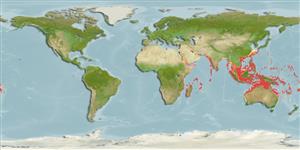>
Mulliformes (Goatfishes) >
Mullidae (Goatfishes)
Etymology: Parupeneus: Latin, parum, parvum = small + Peneus, the name of a river.
More on author: Lacepède.
Issue
FishBase common name changed from Gold-saddle goatfish to Goldsaddle goatfish (Uiblein et al., 2024: Ref. 130857).
Environment: milieu / climate zone / depth range / distribution range
Ekologi
laut berasosiasi dengan karang; nir-ruaya; kisaran kedalaman 0 - 125 m (Ref. 90102). Tropical; 30°N - 35°S, 35°E - 124°W (Ref. 54393)
Indo-Pacific: Red Sea and east coast of Africa south to Durban, South Africa, east to the Hawaiian Islands, islands of French Polynesia and the Pitcairn Islands, north to the Ryukyu Islands and Ogasawara Islands, Japan south to Australia.
Size / Weight / umur
Maturity: Lm ? range ? - ? cm
Max length : 50.0 cm TL jantan/; (Ref. 30573); common length : 35.0 cm TL jantan/; (Ref. 30573); Berat maksimum terpublikasi: 2.3 kg (Ref. 4887)
Duri punggung (Keseluruhan (total)) : 8; duri punggung lunak (Keseluruhan (total)) : 9; Duri dubur: 1; Sirip dubur lunak: 7. This species is distinguished by the following characters: pectoral rays 16 (rarely 15 or 17); gill rakers 6-7 + 22-26 = 29-33; body depth 3.25-3.8 in SL (body deeper with growth); head length (HL) 2.85-3.1 in SL; snout long, its length 1.61.8 in HL; eye small, the orbit diameter 5.3-8.95 in HL (SL 118-392 mm); barbels very long, 1.15 in HL to longer than head; longest dorsal spine 1.5-1.7 in HL; penultimate dorsal ray 1.1-1.2 in length of last dorsal ray; pectoral-fin length 1.5-1.7 in HL; pelvic-fin length 1.35-1.55 in HL. Colour of large adults yellowish gray, edges of the scales bright blue except ventrally, edges more broadly blue posteriorly; a large, hemispherical, saddle-like, yellow spot covering most of upper half of caudal peduncle; region around eye yellow with radiating short narrow blue bands; caudal fin with longitudinal blue bands; second dorsal and anal fins with narrow oblique blue bands; a second smaller color phase entirely yellow, with dorsal peduncular spot sometimes apparent by being brighter yellow than rest of body (Ref. 54393).
Found on coral (Ref. 58652), rocky, or rubble bottoms of reef flats, lagoons, and seaward reefs (Ref. 3921). Benthopelagic (Ref. 58302). Juveniles form schools, adults usually solitary. Feed primarily on small fishes, crustaceans, peanut worms, shrimps, crabs, octopi, and small gastropods during the day (Ref. 3921). Minimum depth reported taken from Ref. 128797.
Life cycle and mating behavior
Kematangan | Reproduksi, perkembang biakan | Pemijahan | telur-telur | Fecundity | Larva
Randall, J.E., 2004. Revision of the goatfish genus Parupeneus (Perciformes: Mullidae), with descriptions of two new species. Indo-Pac. Fish. (36):64 p. (Ref. 54393)
Status IUCN Red List (Ref. 130435: Version 2024-2)
ancaman kepada manusia
Reports of ciguatera poisoning (Ref. 4690)
penggunaan manusia
Perikanan: komersial; Ikan buruan: ya; Akuarium: Komersial
Alat, peralatan
laporan khas
muat turun XML
Sumber internet
Estimates based on models
Preferred temperature (Ref.
123201): 24.5 - 29, mean 27.8 °C (based on 1578 cells).
Phylogenetic diversity index (Ref.
82804): PD
50 = 0.5000 [Uniqueness, from 0.5 = low to 2.0 = high].
Bayesian length-weight: a=0.01259 (0.00802 - 0.01977), b=3.09 (2.96 - 3.22), in cm total length, based on LWR estimates for this species & Genus-body shape (Ref.
93245).
Trophic level (Ref.
69278): 4.2 ±0.6 se; based on diet studies.
Daya lenting (Ref.
120179): sedang, Waktu penggandaan populasi minimum 1.4 - 4.4 tahun (Preliminary K or Fecundity.).
Fishing Vulnerability (Ref.
59153): Moderate vulnerability (40 of 100).
Nutrients (Ref.
124155): Calcium = 23.4 [12.2, 58.4] mg/100g; Iron = 0.3 [0.1, 0.7] mg/100g; Protein = 18 [15, 21] %; Omega3 = 0.132 [0.073, 0.254] g/100g; Selenium = 61.8 [28.3, 147.8] μg/100g; VitaminA = 292 [55, 1,307] μg/100g; Zinc = 0.39 [0.23, 0.74] mg/100g (wet weight);
